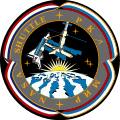STS-58
David Wolf served as mission specialist 3 aboard Columbia during the STS-58 mission. STS-58, designated Spacelab Life Sciences 2, was the second dedicated mission to study regulatory physiology, cardiovascular/cardiopulmonary, musculoskeletal and neuroscience. The mission lasted 14 days, 0 hours, 12 minutes and 32 seconds. Columbia landed at Edwards Air Force Base in California. At the time of landing STS-58 was the longest duration mission flown. [5]
Mir Expedition 24
Wolf flew aboard Atlantis on STS-86 in September 1997. Wolf was only on board for a short time as he was being transported to the Russian Mir space station. Atlantis docked with the Mir space station on September 27, 1997, which marked the start of Dave Wolf's stay on Mir. [6]
David Wolf spent 128 days aboard space station Mir. He conducted a number of experiments and studies including, advanced microgravity tissue engineering techniques, electromagnetic levitation platform capability, colloid behavior, radio-tracer studies of altered human erythropoetic function, and human microgravity physiology studies. During his stay, there were a number of systems failures including multiple failed spacecraft systems, including atmospheric life support, three total power system failures, loss of attitude control, primary computer system failure, humidity separation system loss. An emergency ingress had to be made during an EVA performed in the Russian Orlan space suit due to airlock hatch failure. [7] The entire mission and training were conducted solely in Russian. [8]
While aboard Mir, Wolf became the first American to vote from space, casting a ballot in a 1997 local election. [9]
STS-89 was David Wolf's return ride home to earth. STS-89 docked with Mir on January 24, 1998, marking the end of Wolf's stay on Mir. Endeavour touched down on January 31, 1998. [7]
STS-112
Dave Wolf flew aboard Atlantis during the STS-112 mission. STS-112 delivered the S1 truss segment the International Space Station (ISS). Atlantis launched on October 7, 2002, from Kennedy Space Center. Wolf conducted 3 spacewalks, to install the S1 truss segment and other EVA hardware. He spent a total of 19hrs and 1 minute outside the ISS. Atlantis landed on October 18, 2002, ending STS-112 at 10 days, 19 hours, 58 minutes and 44 seconds. [10]
STS-127
David Wolf last flew on Endeavour during the STS-127 (2J/A) mission. The STS-127 launched on July 15, 2009, and the mission delivered the Japanese Experiment Logistics Module – Exposed Section (ELM-ES) and new expedition member Timothy Kopra. STS-127 was originally scheduled to launch in June 2009 but was delayed after a leak was detected at the gaseous hydrogen vent line. A second attempt was made 3 days after the first try but was scrubbed for the same problem. A third launch attempt was canceled due to bad weather and a further delay occurred when lightning struck near the pad. Wolf conducted 3 spacewalks, totaling 18hrs 24min. STS-127 landed on July 31, 2009, and lasted 15 days, 16hrs, 44min and 58seconds. [11]


